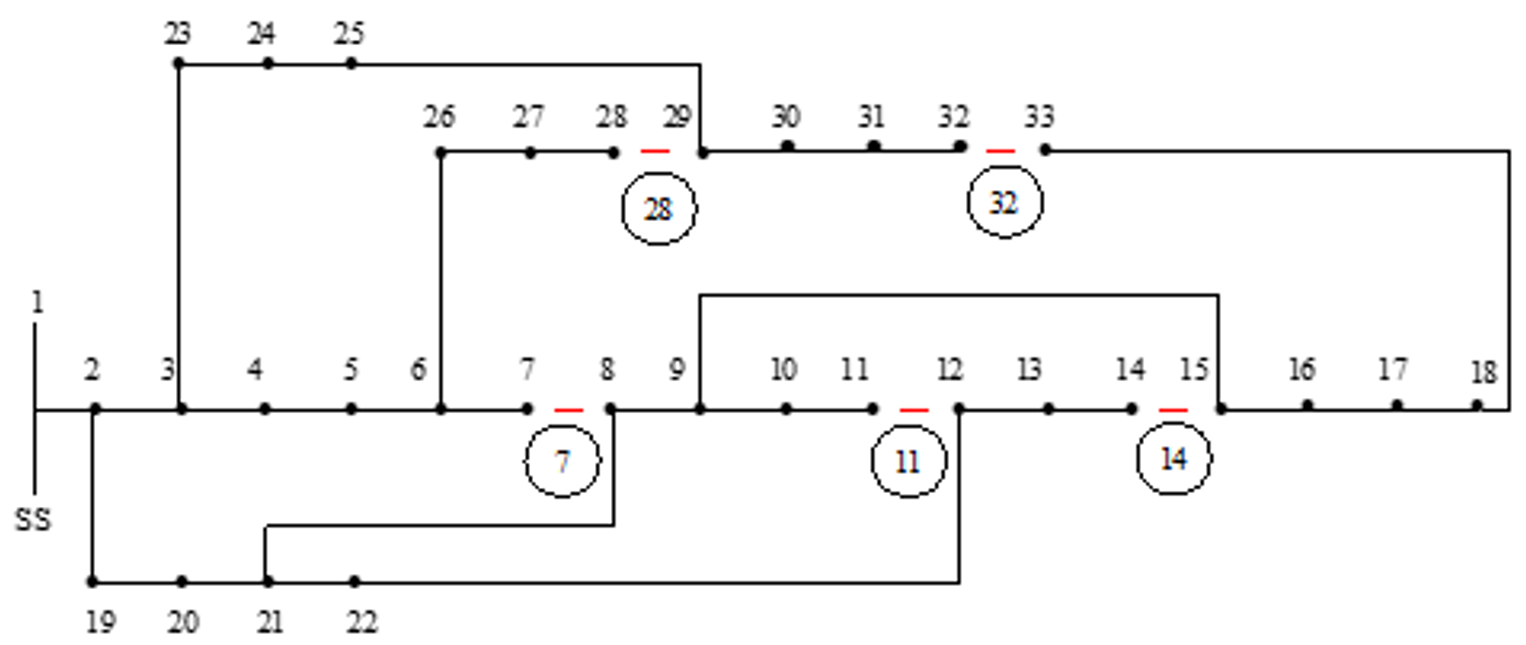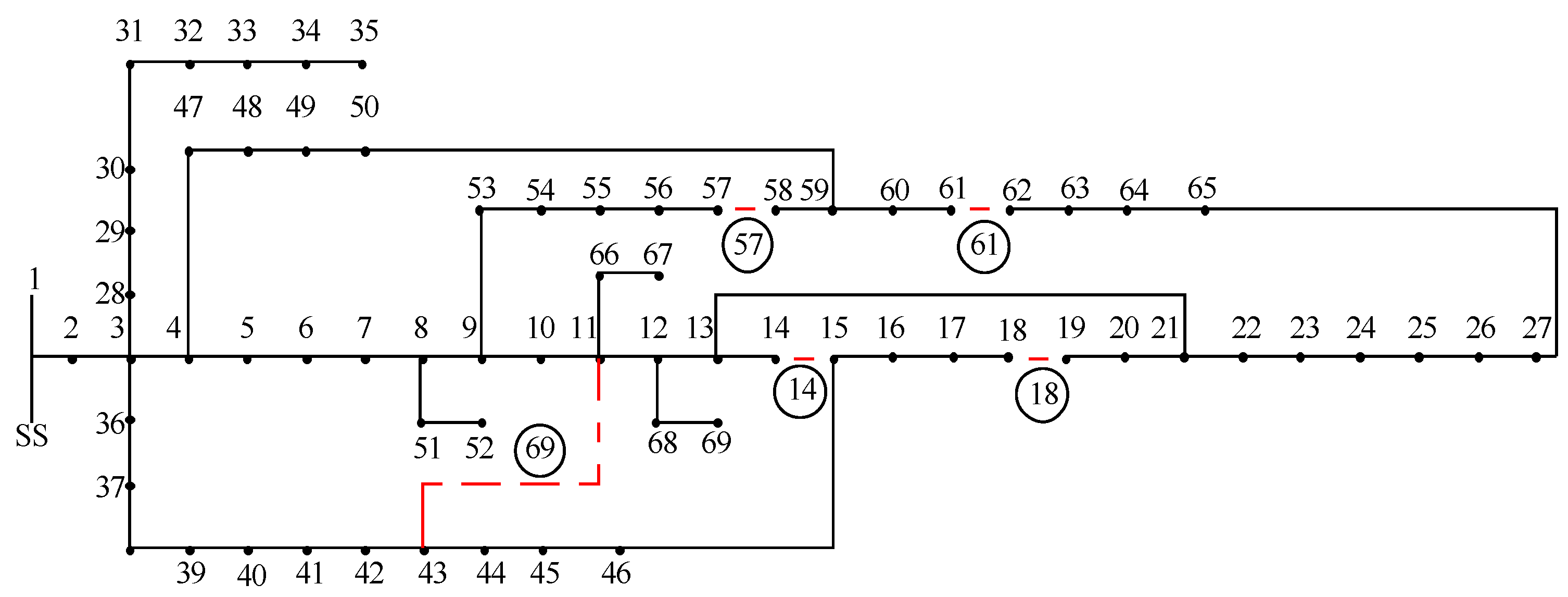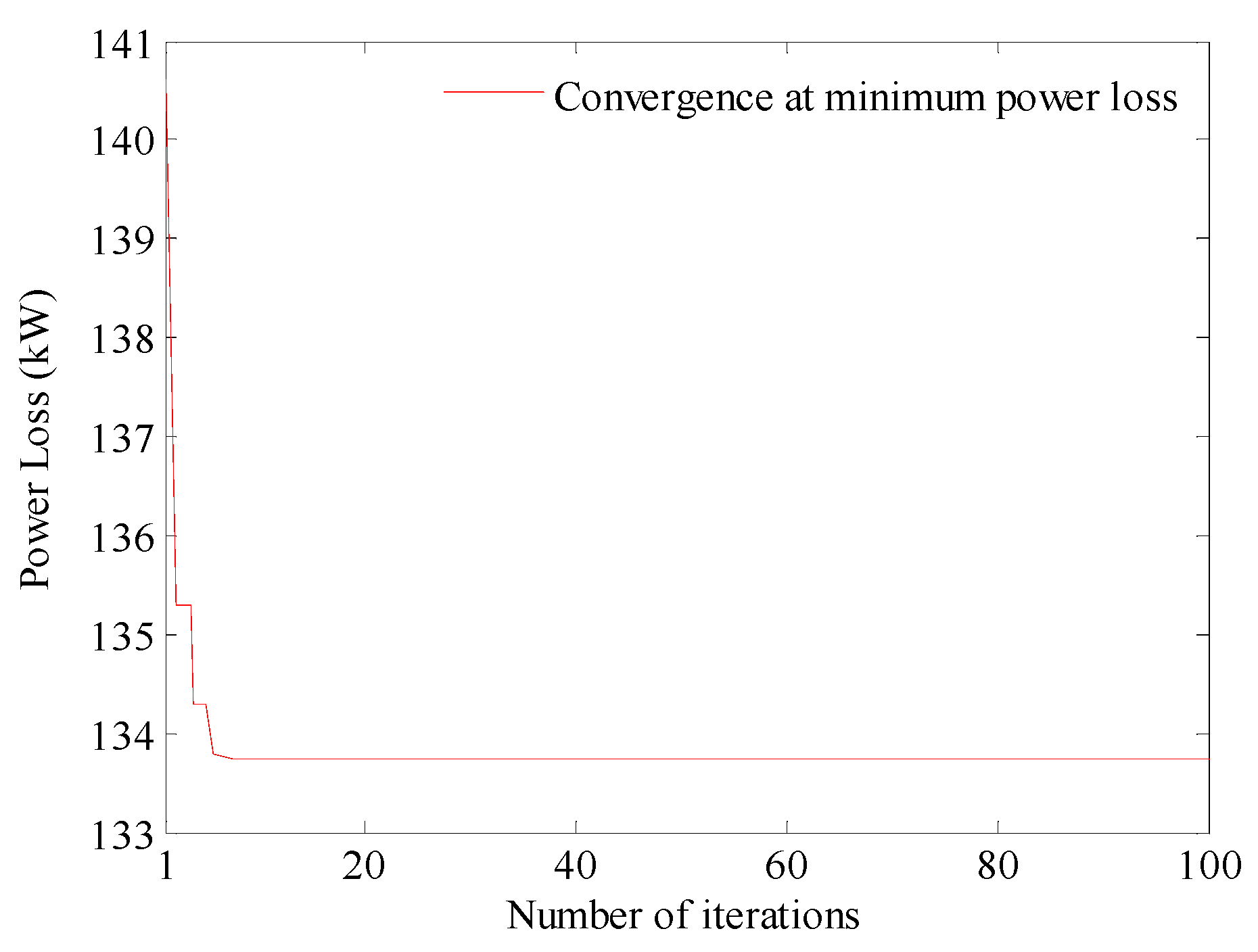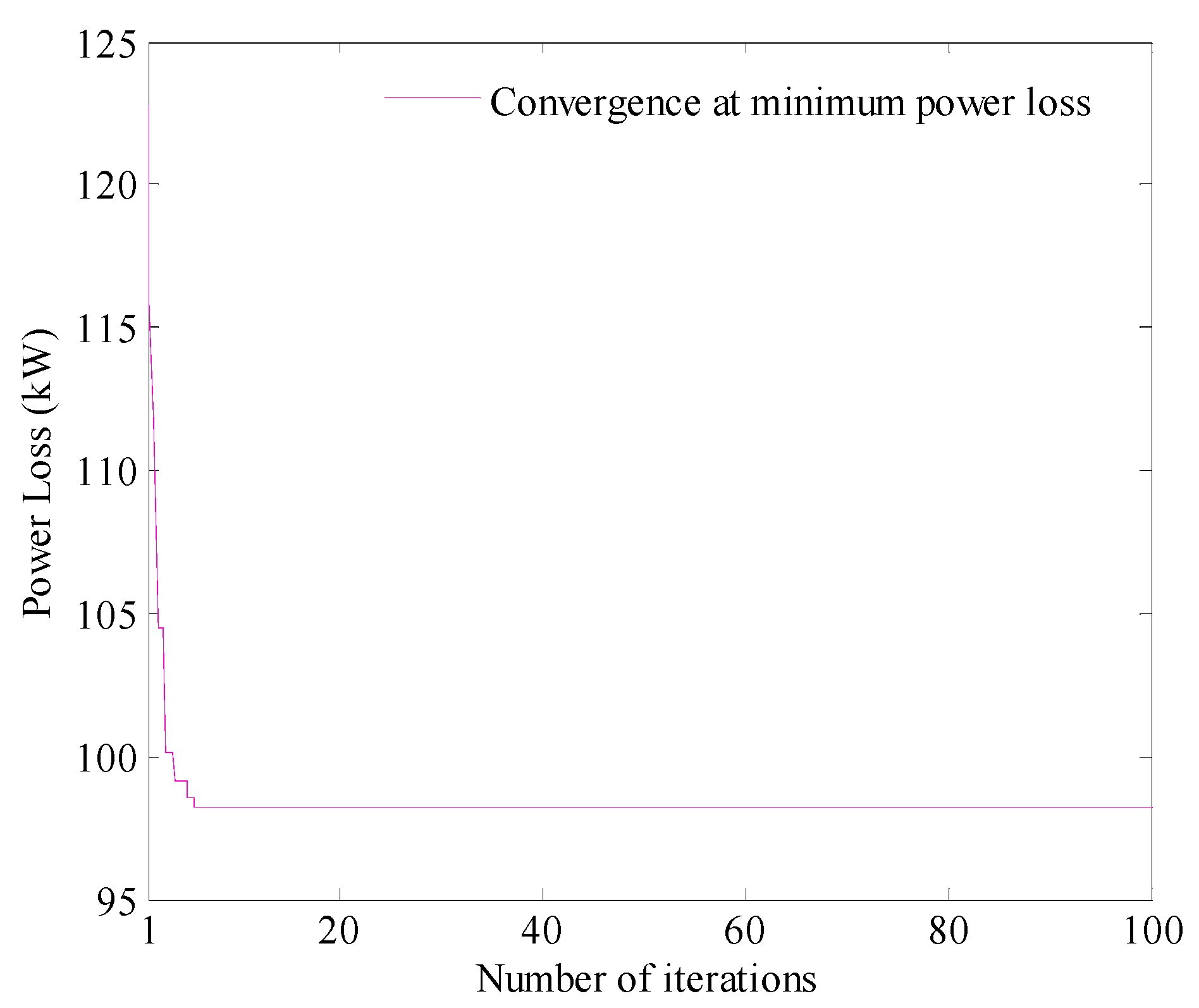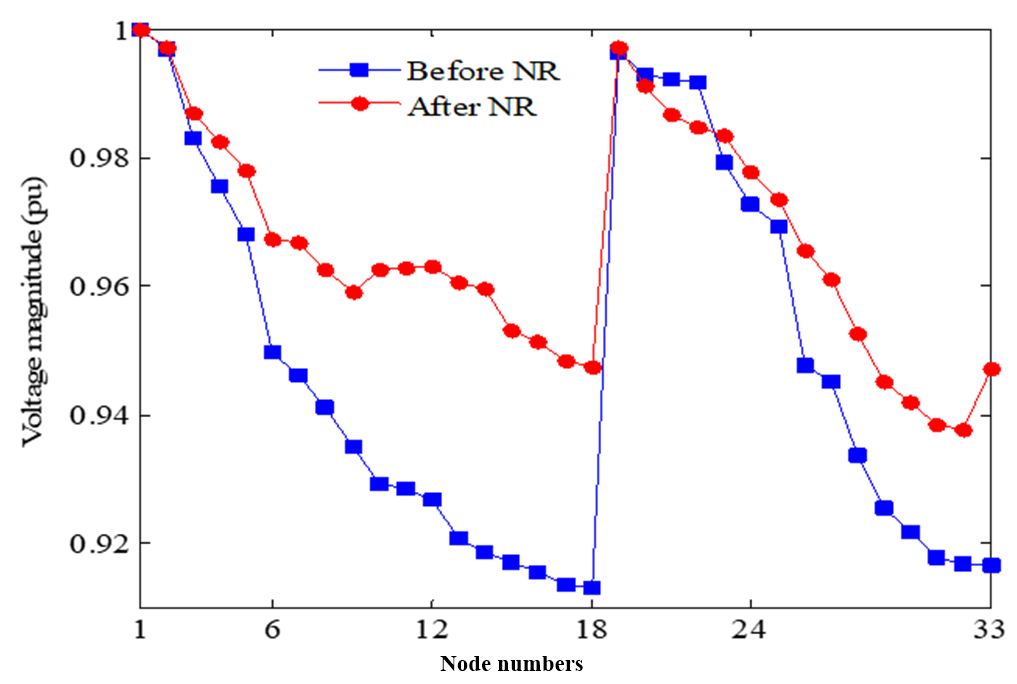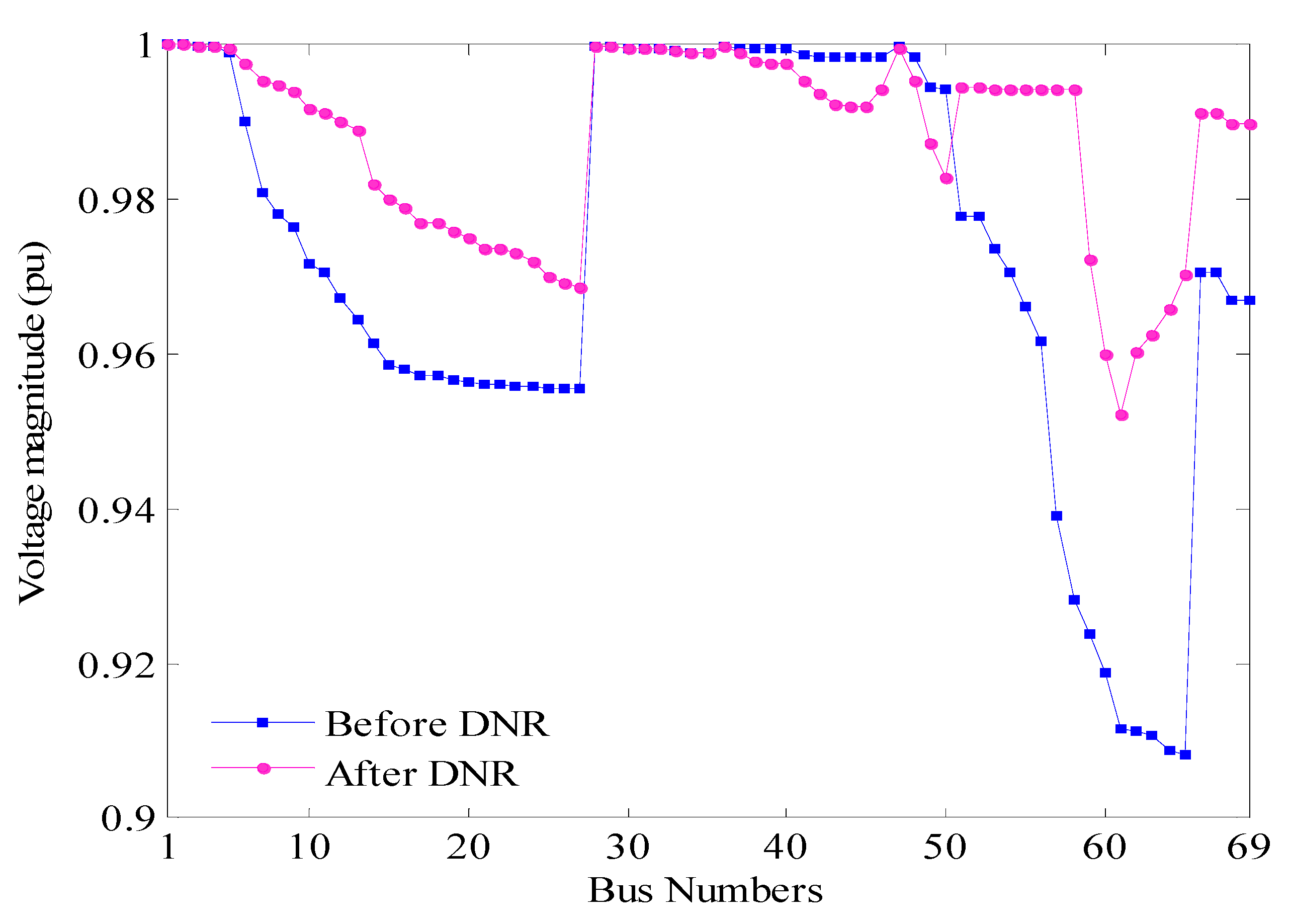1. Introduction
An electrical power distribution system is a crucial network that carries power in the last few miles from a transmission or subtransmission system to consumers in an electrical power system. It is differentiated from a transmission system by its voltage level and topology. Generally, a distribution system is considered to be operating at a low voltage. As a consequence, a distribution system suffers from higher ohmic losses than a transmission system, which results in consumers not receiving the full electric power distributed in the network by a distribution company. This directly affects the sector’s economic profitability and customers who pay for power services. Distribution networks are typically constructed as interconnected networks, while in operation, the topographic anatomy is organized in the shape of a radial tree. This means that such systems are divided into radial feeder subsystems. These radial feeders have a set of disconnect switches installed at strategic network points. These opening and closing disconnect switches modify the network topology, which is called network reconfiguration, and depending on the configuration of the switches, energetical waste can be minimized. Selecting the set of open/close switches can be modeled as an optimization problem, with the model being subjected to a variety of operating and physical constraints. Usually, the DNR problem is a highly nonlinear, mixed-integer, nondifferentiable, and intricate combinatorial optimization problem concerning the need to minimize total power loss. Hence, a suitable optimization tool must be developed to ascertain the optimal operational setting for the distribution system.
1.1. Recent Research Works
In recent years, a number of optimization techniques have emerged that can smooth the process of determining the optimal solution to complex engineering problems, which have previously been troublesome or not viable at all. These optimization techniques are based on metaheuristic algorithms. Such algorithms are intelligent, free of derivation, nondeterministic, explicitly applicable to all problems, and motivated by social behavior; furthermore, their randomness characterizes the need for an appropriate balance between exploration and exploitation of the system under consideration. A metaheuristic algorithm’s control variable leads to a global optimal solution, whereas mathematical approaches struggle to discover a specific answer. Therefore, metaheuristic optimization is considered an efficient tool for resolving nonlinear problems [
1].
As previously stated, researchers are driven to tackle the problem of DNR because it is not a solution to just one specific problem, has less of a focus on an early solution, and has the potential to address any large-scale and complicated challenges in power system problems. It can be analytically expressed as a statement of the optimization problem with various system operation constraints to determine the ideal radial distribution network for minimizing line losses or maximizing benefits under typical system operating conditions [
2,
3].
Various metaheuristic algorithms have been confirmed as having the capability to solve the problem of DNR. These include, for instance, bacterial foraging optimization as presented in [
4]; the ant colony search algorithm (ACSA) as proposed in [
5]; the harmony search algorithm [
6] and the cuckoo search algorithm (CSA) as described in [
7]; particle swarm optimization (PSO) as presented in [
8]; and invasive weed optimization as reported in [
9]. In addition, the search capability of the sophisticated genetic algorithm described in [
10]; the specialized genetic algorithm proposed in [
11]; the application of fuzzy set theory based on a heuristic algorithm described in [
12]; the modified shuffled frog-leaping algorithm [
13] and the improved adaptive imperialist competition algorithm (IAICA) presented in [
14]; and the modified BFOA (MBFOA) proposed in [
15] are very well tuned to achieve improved convergences while optimizing the distribution network.
Specifically, the merging of PSO with the optimization of honey bee mating—known as the PSO–HBMO algorithm—has improved the exploration ability in the search region while reconfiguring the distribution system under study [
16]. Mostafa et al. developed a hybrid BB–BCA [
17]. Researchers have also incorporated the combination of PSO and the big bang–big crunch algorithm into the analysis of network reconfiguration alone, and then used the same algorithm for the problem of DNR during the incorporation of capacitors [
18].
Recently, Quadri et al. proposed a new metaheuristic method, which includes the comprehensive teaching and learning of harmony search optimization algorithm (CTLHSO), for solving the network reconfiguration problem [
19]. Following that, Tran et al. exercised a stochastic fractal search (SFS) algorithm for optimizing a distribution system when distributed generation is present [
20], and Haider et al. employed a PSO algorithm with multi-objective functions in a radial network to find the optimal placement and size of DGs before and after reconfiguration [
21]. At the same time, an improved harmony search algorithm [
22] was proposed that featured continuous variables standing in for the power flowing through the branches and the integer variables. A search strategy was incorporated into the SGA in a customized metaheuristic algorithm known as the CSGA [
23]. The new search algorithm, which was inspired by the equilibrium optimizer (EO) algorithm [
24], has been applied in order to reduce the loss of active power and achieve better voltage magnitude by reconfiguring a radial distribution network.
Most recently, Dhivya et al. proposed a chaotic golden flower algorithm (CGFA) in which the flower pollination algorithm and the golden search method are combined to optimize a distribution network for the evolution of smart cities [
25]. At the same time, Khasanov et al. proposed to solve the network reconfiguration problem by using the Mayfly algorithm (MA) to curtail the loss of power in a distribution network. The social behavior of mayflies inspired this algorithm [
26].
1.2. Research Gap
However, the above-described optimization methods have been identified on the basis of optimal results; they have not been put forward as a global solution to the proposed problem of DNR because of their general imperfection due to the complexity of these algorithms’ premature convergence, the imbalance between exploitation and exploration, and the high value of time required for the computational features of these algorithms. According to current research, finding a practical solution requires striking an accurate balance between metaheuristics’ intensification and diversification techniques. In ref. [
16], PSO’s global search behavior is merged with HBMO’s local search behavior, whereas in refs. [
17,
18], BB–BC’s exploration capacity is mixed with PSO’s exploitation ability. Despite this, various algorithms have been proposed to provide radial networks with an optimal solution. Even though these algorithms have discovered an optimal structure for radial systems, their solution is not the complete key to solving the DNR problem: the DNR problem is a tricky conjugational problem, with control variables of a discrete nature (tie position, sectionalizing switches, etc.) that must be analyzed for every iteration to identify the best distribution network with a radial structure.
1.3. Motivation
To overcome this shortcoming, an effective tool used for optimization, namely the gray wolf optimization (GWO) method, is selected for its proper handling of the constraint tactics of the system under study, which balances diversification and intensification through the surrounding, hunting, and attacking processes. Moreover, the proposed GWO method’s convergence and performance are better than those of other optimization techniques as the method has been successfully investigated for its ability to solve standard test functions, complex engineering problems, economic load dispatch problems [
27,
28,
29], and the unit commitment problem [
30]. Moreover, in the design of a modular granular neural network architecture, the gray wolf optimizer has been proposed and applied for human recognition based on the face, iris, and ear [
31]. A modification to the GWOA depends on how the realization of a fuzzy logic hierarchical operator is performed [
32]. Moreover, the GWO algorithm [
27,
28,
29,
30] has demonstrated its capacity to discover high-quality solutions for standard test functions, complicated engineering problems, economic load dispatch, and the unit commitment problem. It is also driven to optimize the control variables of the DNR problem. When the coefficient vector (A) and the acceleration set (a) in the position of gray wolves are updated and decreased from an upper value linearly to zero, a balance between intensification and diversification is required for the system to discover the most satisfactory solution and achieve the local optimum quickly. As a result, the GWO algorithm is introduced in this study to discover real solutions to the DNR problem.
1.4. Highlights and Organization of the Paper
As a first attempt, the GWO algorithm is exercised for solving the DNR problem.
The system constraint infringement is appropriately addressed, based on a suitable proposed scheme.
A new, fangled DNR framework is proposed to diminish the power loss.
Conditions for the solution within the optimal range are obtained within a shorter time.
This paper is divided into six sections. In
Section 2, the formulation of the DNR problem is set out.
Section 3 depicts the optimization tool incorporated into the system for the mathematical formulation of the GWO algorithm.
Section 4 deals with the conclusion of the optimal radial network functioning structure using the GWO algorithm. The simulation results are validated in
Section 5. Lastly, the research work is concluded in the final section.
2. Articulation of the DNR Problem
A power distribution system has an extensive network connected to other networks in a mesh configuration. Under typical operating conditions, these are arranged as a radial construction with the incorporation of sectionalizing switches/tie switches to disperse the total load among all the feeders and to provide the system with simple protection. As a result, the DNR problem is defined as the task of modifying a distribution network to preserve the optimal radial operational structure. The DNR problem is posed as a challenging, conjugational, and nondifferentiable restricted computation to achieve profiles with better voltage and power loss reduction.
2.1. Objective Function
The following is a mathematical definition of the minimization problem of the objective functions considered in this section. The sum of the active power to be minimized is simulated using the branch current variable based on Equation (1):
where
Pi and
Qi are denoted as the load powers (active and reactive power) of the
i-th bus;
Vi is the
i-th bus magnitude of voltage; the branch resistance is
Ri; and
TS and
SW are the tie and sectionalizing switches, respectively.
2.2. Constraints
After reconfiguration, the bus voltages should be within the system operator’s allowable range (2):
where
Vmin and
Vmax are denoted as the minimum value and the maximum value of pu node voltages of the
jth node, respectively. The formula for the capacity of specified current in the branch according to its rating is as follows (3):
where |
Il| and
Iimax are, respectively, the
i-th current in the branch and the
i-th branch maximum current-carrying capacity in ampere.
3. Gray Wolf Optimization
This population-based metaheuristic algorithm [
19] is based on the behavior of gray wolves in nature, which stands out for its leadership hierarchy and methods used for hunting. Gray wolf populations typically have a pack size of five to twelve individuals, and the cluster organizes itself efficiently within a hierarchy in which the most dominating member is known as the alpha, and the next three wolves in rank order are beta, omega, and delta, with beta assisting with decision-making and the lowest rank being occupied by omega.
Hunting is a capturing behavior of gray wolves. By emulating this behavior, a gray wolf optimization technique was developed, in which a group of gray wolves is randomly allowed to look for a prey in a multidimensional environment. The wolves’ positions are regarded as variables and they should be optimized. The distance between the gray wolves and the prey determines the objective function’s fitness value. Each gray wolf changes its position continuously and goes to the most satisfactory position according to the instruction and feedback of the system based on the optimization algorithm. The best achievable solution can be found during the iterations.
The GWOA’s mathematical formulation is also used as shown below for the following behaviors to find the best possible solution:
- i.
Encircling;
- ii.
Hunting;
- iii.
Offensive.
The gray wolves’ circling etiquette is mathematically described in (4) and (5):
where
t denotes the current iteration; the coefficients of the vectors are
and
; the vector
denotes the position of the prey; and the vector
is the position of a gray wolf. The vectors are represented in (6) and (7) as follows:
where
and
are denoted as random vectors between 0 and 1, and the set value
diminishes from 2 to 0 over the course of the iterations.
Throughout the iterations, the updated location of the best candidate solution (alpha) appears first, followed by the positions of the delta and beta wolves. Finally, the search agents update the positions of the omega wolves, depending on the positions of the search agents, with the three best values, which can also be modeled as follows (8):
where
During the iterations, the vector value linearly decreases from 2 to 0; thus, the vector also decreases because of a decrease in the value of . Since the vector fluctuates randomly between the range of [−2a, 2a], suggests, finally, that the optimization is converging toward the prey. Such a case means that the wolves are coerced to assail the prey or that the wolves move to look for a better candidate solution (alpha), which continues until the convergence of optimization.
4. Application of GWO to the DNR Problem
The steps involved in the implementation of GWO to optimize the distribution network configuration problem are as follows:
Step 1—Control variables’ initialization: The tie switches are the control variables and must be opened and maintained for a viable radial network topology. Therefore, the GWO algorithm parameter must be initialized in terms of the control variables. The abovementioned control variables are all described as integer numbers. The total number of control variables is equal to the number of tie switches, and its sum is picked randomly from each fundamental loop. As a result, the N
L is the total no. of fundamental loops, and it is calculated as follows:
where
Nbr and
Nbus are the nos. of branches and buses, respectively, and
Nss is the number of substations.
Step 2—Structure of candidate solution: This is an integer number, and for each loop, one control variable is chosen, so the no. of tie switches is equal to the no. of basic loops that are required to be opened to protect the radial structure, i.e., (
=
). Then, a random integer with a uniform distribution is generated as shown in (13):
Equation (14) represents the matrix structure with the initial population, where NP is the population number.
Step 3—Augmented objective function and estimation: The radial structure is appropriately realized from the population’s beginning position. For each trial solution, the objective value is computed. The following sequential procedures for radial topology are checked for the determination of the objective value:
- i.
The matrix of A (b, b) is initialized, where A is the loop distribution network matrix, b is the no. of buses, and S is a set of feeders: S = [feeder1, feeder2, … feeder k]. The matrix A and its entries are defined as follows:
If node i is interconnected to node j, then A (i, j) = A (j, i) = 1.
If node i is not interconnected to node j, then A (i, j) = A (j, i) = 0.
- ii.
If there is a tie switch from node i to node j, then A (i, j) = A (j, i) = 0. Read the trial solution.
- iii.
Estimate for the load nodes: If node n∉S and A (m, n) = 1, with n = k + 1, k + 2, …, b and m = 1, 2, …, length (S), then node n is moved to S, S = S + [node n] and A (n, m) = A (m, n) = 0.
- iv.
If S = b and matrix A is a zero matrix, then the reconfiguration of a radial network is a trial solution.
The objective function is generated using a typical distribution of the load flow algorithm. The implementation handles the violation of constraints with an improved objective function, denoted as AOF and developed on the basis of Equation (15). It is the collective objective function. The squared sum of the current (
SCI) and the violation of voltage (
SCV) constraints with a scalar multiplier have a high value. This method also distinguishes the fundamental unconstrained problem from the confined problem, thus guiding the process to search for the desired solution (15):
where
λV and
λI are the penalty constraints. The
SCV and
SCI found are based on Equations (16) and (17):
Step 4—Fitness and the best position evaluation: The present candidate solution matrix (Xo) is used to find the fitness value of all individuals using Equation (18). The fitness of the
i-th individual represents the distance of the wolf from the prey, and the entire population is graded based on the fitness value from lowest to highest; alpha represents the lowest fitness, and the second and third lowest fitness values are represented by beta and delta (18):
Step 5—Optimal solution by modifying agent position: According to Equation (8), the i-th agent’s modified position must be updated. Each and every search agent’s position indicates a potential solution, consisting of various tie switch openings from each loop.
Step 6—Fitness re-estimation: A regular load flow is conducted with the revised position of every control variable, and the augmented objective function is computed as explained in steps 3 and 4 to find the global optimal solution.
Step 7—Stopping of criterion: If iteration ≤ maximum cycle (500), then go to step 3. Otherwise, the GWO algorithm has converged and is terminated.
Time Complexity Computation of GWO
The GWOA’s time complexity for obtaining the optimal solution for the DNR problem is computed using the pseudo-code and the execution procedures. The computation consists of four phases that can be articulated as follows:
- i.
Initialization phase (IP): There are two nested loops; the first one is N time iterates, which is the wolves’ size, and the second one is d time iterates, which is the control variable dimensionality.
- ii.
Phase of GWO algorithm (PGA): This consists of the GWO operator, and it means that the prey is encircled. It has a While loop with a single For loop within it. The maximum cycle times for the iterates of the While loop and for the For loop iterates are N times in every iteration.
The three best solutions are selected using a greedy selection mechanism; here,
L is equal to
N. Then,
- iii.
Phase of objective function computation (POFC): For each iteration, the objective function is computed for the “d” control variables.
- iv.
Solution repair phase (SRP): This phase involves the solutions obtained for the “d” control variables.
The overall time complexity for obtaining the optimal solution for the DNR is as follows:
5. Applications of GWO for the DNR Problem
In general, the main benefits of a metaheuristic algorithm rely on setting the values of the control parameters and the strategy used for avoiding premature convergence. Thus, this section focuses on the successful implementation of the GWO algorithm for optimizing DS to minimize power loss.
5.1. System Data
The GWO algorithm’s performance was investigated using two standard IEEE test systems. Test system I has a value of 12.66 kV, 33 nodes, and a radial system of 10 MVA with 32 sectionalizing switches and 5 tie switches numbered 33, 34, 35, 36, and 37. The overall load during normal operating conditions is 3.72 MW and 2.3 MVAR, with a power loss of 202.67 kW and a minimum voltage per unit of 0.913. All pertinent information is contained in [
1]. Test system II has a value of 12.66 kV, 69 nodes, a radial system with 68 sectionalizing switches and 5 tie switches, with a total connected load of 3.802 MW and 3.696 MVAR. The open switches are 69, 70, 71, 72, and 73 in normal operation; the loss of power and the minimum pu voltage are 224.95 kW and 0.9092, respectively [
2].
5.2. Simulation Tool
To minimize the power loss in small and medium distribution systems, the DNR problem was modeled using the GWO algorithm. The GWO algorithm was implemented in MATLAB 8.1 and tested on a digital computer. Thirty separate trials were conducted for each instance to determine the best, average, and worst outcomes. The outcomes of the simulated test systems were compared with the results of earlier approaches to prove the algorithm’s resilience.
5.3. Possible Reconfiguration
The objective function was minimized based on the optimal position selection of the system’s tie switches, and the GWO technique’s usefulness in solving the DNR problem was investigated.
Table 1 and
Table 2 depict test system I and test system II, showing the numerous selections of optimal tie switches based on the GWOA, the power loss that occurs, the minimum voltage at node, and the computing time. When switches 7, 14, 11, 32, and 28 are open in test system I, the power loss is minimal and the node voltage improves, whereas this situation occurs when switches 69, 18, 14, 57, and 61 are open in test system II.
Figure 1 and
Figure 2 depict the optimal DNR of test system I and test system II in this scenario, revealing the network’s radiality.
5.4. Comparison of the Best Possible Solution
The supremacy of the GWOA was used to solve the DNR problem, and the simulation outcomes were compared with those obtained from the CSA [
7], IAICA [
14], MBFOA [
15], SFSA [
19], CTLHSO [
20], PSO [
21], HIS [
22], and EO [
24] methods; the comparison results for test system I and test system II are shown in
Table 3 and
Table 4. The reductions in the loss of power values for the CSA [
7], IAICA [
14], MBFOA [
15], SFSA [
19], CTLHSO [
20], PSO [
21], HIS [
22], EO [
24], and GWO methods are 63.20 kW, 63.14 kW, 63.16 kW, 63.84 kW, 68.19 kW, 63.16 kW, 64.57 kW, 68.99 kW, and 63.16 kW, respectively, based on the initial configuration in test system I, whereas the values are 126.8658 kW, 126.13 kW, 126.15 kW, 126.8685 kW, 126.8765 kW, 126.82 kW, 126.87 kW, 127.2395 kW, and 126.8413 kW in test system II.
Furthermore, it can be seen that the GWO algorithm considerably reduces the power loss compared to the other optimization algorithms in both test systems. Indeed, the GWO algorithm reduces the loss of power by 34.03% and 56.44% in test systems I and II, respectively. Similarly, the GWO algorithm regulates the voltages of the nodes by 6.24% and 5.02% in test systems I and II, respectively. Therefore, the network losses are the lowest in the implemented method.
Figure 3 and
Figure 4 show that the GWO algorithm possesses fast and stable convergence characteristics, while the power loss is minimized in both test system I and test system II.
5.5. Improvement over State-of-the-Art Literature
Table 5 compares the performance of the GWO algorithm in achieving the given objectives to the optimization approaches of well-known techniques that have already demonstrated their capacity to solve the problem. The loss of power reduction is 5.7819 kW, 5.1419 kW, 0.7919 kW, 5.8219 kW, 4.4119 kW, and 5.8219 kW better than the CSA [
7], IAICA [
14], MBFOA [
15], SFSA [
19], CTLHSO [
20], PSO [
21], IHS [
22], and EO [
24] methods in test system I, respectively, whereas in test system II, the reduction in power loss is 0.3737 kW, 0.3710 kW, 0.3630 kW, 0.4230 kW, 0.3730 kW, and 0.3982 kW greater than the CSA [
7], IAICA [
14], MBFOA [
15], SFSA [
19], CTHSO [
20], and EO [
24] methods, respectively.
The minimum node voltages calculated based on the GWO are 0.0024 pu, 0.0019 pu, 0.0064 pu, 0.0161 pu, and 0.0064 pu higher than the values for the CSA [
7], IAICA [
14], SFSA [
19], CTLHSO [
20], PSO [
21], IHS [
22], and EO [
24] methods, respectively, for test system I. In comparison, the minimum node voltages of test system II are 0.0022 pu, 0.0027 pu, 0.00570 pu, and 0.0027 pu higher than the values for the CSA [
7], IAICA [
14], SFSA [
19], CTLHSO [
20], and EO [
24] methods, respectively. The profiles of the system voltages for test systems I and II are shown in
Figure 5 and
Figure 6. The node voltages were compared before and after the reconfiguration of the network. It is concluded that the voltage magnitude is significantly enhanced after the network reconfiguration using the proposed algorithm for the vast majority of nodes.
5.6. Validation of the Best Solution Obtained Using GWO
The standard statistical data analysis procedure revealed some interesting findings, i.e., the minimum, maximum, and mean for each attribute including the associated standard deviation. Thus, the potential solution to the DNR problem was statistically examined, and the system test results for the system with 33 nodes are shown in
Table 6, while the test results for the system with 69 nodes are depicted in
Table 7. The tables relating to each system show the minimum, average, and maximum values for the final solutions. It is observed that the minimum solution was obtained by the GWO algorithm over thirty trials, and that the average value obtained is very close to the minimum value obtained by the ICIAC [
14] and MBFOA [
15]. The standard deviations have the lowest value when the GWO algorithm was used. The values of 93.33% and 86.67% are the success rates when optimizing test system I and test system II with the implementation of the GWO algorithm. This means that, comparatively, good-quality solutions 28 and 26 lie between the minimum and the average solutions over thirty trials.
6. Conclusions
By executing network reconfiguration, the potent metaheuristic algorithm GWO was effectively used to trim down the loss of power in a distribution system (DS). The DNR problem is a challenging, confined, nondifferentiable, and combinatorial issue. Both the network reconfiguration and the loss of power in all feeder branch sections are regarded as objective functions. The forward-/backward-sweep distribution of the load flow technique was used in the solution procedure to find the objective function. The GWO method, which imitates the natural behavior of gray wolves that circle, hunt, and attack their prey, was utilized to tackle this problem. Using 33- and 69-bus DSs, simulation was conducted for the reconfiguration of the network. The simulation outcomes were contrasted with those from other implementations; the optimal tie switch determination was distinguished, and in the initial state, the obtained configuration was independent of the DSs. Additionally, a way to lessen the significant power loss in radial DSs was provided in this work, and the improvement was thoroughly examined. The results showed that the proposed GWO algorithm was a reliable and realistic algorithm for determining the overall optimal DS reconfiguration. This research work was limited to a balanced testing system with a fixed load and an optimized single objective function.
The next stage of research work should cover the application of the GWO algorithm to distribution systems in practice. The topics for subsequent research effort should include completing network reconfiguration in the presence of DG, placing DG after reconfiguration, and, subsequently, tackling a different type of DG. Moreover, it is suggested that optimization should be performed on an unbalanced system with a dynamic load pattern and should be multi-objective. Additionally, power distribution firms looking to integrate distributed generation into a DS should benefit from the numerical results of this and future work.
Author Contributions
Conceptualization, P.M. and V.M.; methodology, P.M., V.M. and C.R.R.; software, P.M., V.M. and C.R.R.; formal analysis, V.M.; investigation, P.M., C.R.R. and V.M.; resources, C.R.R.; data curation, M.K.K.; writing—original draft preparation, P.M., M.K.K., B.P., M.K. and M.A.; writing—review and editing, M.K. and M.A.; visualization, B.P.; supervision, C.R.R.; project administration, C.R.R.; funding acquisition, M.K. and M.A. All authors have read and agreed to the published version of the manuscript.
Funding
The authors would like to acknowledge the support from King Khalid University, Abha 62529, Saudi Arabia.
Data Availability Statement
Not applicable.
Acknowledgments
The authors would like to acknowledge the support received from the Saudi Data and AI Authority (SDAIA) and King Fahd University of Petroleum and Minerals (KFUPM) under the SDAIA-KFUPM Joint Research Center for Artificial Intelligence Grant No. JRC-AI-RFP-08, Dhahran 31261, KSA. Additionally, the authors would like to thank King Khalid University for its financial support to this study.
Conflicts of Interest
The authors declare no conflict of interest.
References
- Blum, C.; Roli, A. Metaheuristics in combinatorial optimization overview and conceptual comparison. ACM Comput. Surv. 2003, 35, 268–308. [Google Scholar] [CrossRef]
- Baran, M.; Wu, E. Network reconfiguration in distribution systems for loss reduction and load balancing. IEEE Trans. Power Deliv. 1989, 4, 1401–1407. [Google Scholar] [CrossRef]
- Chiang, H.; Jumeau, D. Optimal Network Reconfigurations in Distribution Systems; Part 2 Solution Algorithms and Numerical Results. IEEE Trans. Power Deliv. 1990, 5, 1568–1574. [Google Scholar] [CrossRef]
- Sathishkumar, K.; Jayabarathi, T. Power system reconfiguration and loss minimization for an distribution systems using bacterial foraging optimization algorithm. Elect. Power Energy Syst. 2012, 36, 13–17. [Google Scholar] [CrossRef]
- Sua, C.; Chang, T.; Chiou, F. Distribution network reconfiguration for loss reduction by ant colony search algorithm. Electr. Power Syst. Res. 2003, 75, 190–199. [Google Scholar] [CrossRef]
- Bao, Z.; Li, Y.; Han, Y.; Guo, C.; Wang, W.; Xie, Y. Multiobjective distribution network reconfiguration based on system homogeneity. In Proceedings of the IEEE PES Asia-Pacific Power and Energy Engineering Conference (APPEEC), Brisbane, QLD, Australia, 15–18 November 2015; pp. 1–5. [Google Scholar]
- Nguyen, T.T.; Truong, A.V. Distribution network reconfiguration for power loss minimization and voltage profile improvement using cuckoo search algorithm. Electr. Power Energy Syst. 2015, 68, 233–242. [Google Scholar] [CrossRef]
- Syahputra, R.; Robandi, I.; Ashari, M. PSO Based multiobjective Optimization for Reconfiguration of Radial Distribution Network. Int. J. Appl. Eng. Res. 2015, 10, 14573–14586. [Google Scholar]
- Sudharani, D.; Subrahmanyam, N.; Sydulu, M. Multiobjective Invasive Weed Optimization –An application to optimal network reconfiguration in radial distribution systems. Electr. Power Energy Syst. 2015, 73, 932–942. [Google Scholar] [CrossRef]
- Zhu, J.Z. Optimal reconfiguration of electrical distribution network using the refined genetic algorithm. Electr. Power Syst. Res. 2002, 62, 37–42. [Google Scholar] [CrossRef]
- Carreno, E.M.; Romero, R.; Feltrin, A.P. An Efficient Codification to Solve Distribution Network Reconfiguration for Loss Reduction Problem. IEEE Trans. Power Syst. 2008, 23, 1542–1551. [Google Scholar] [CrossRef]
- Das, D. Reconfiguration of distribution system using fuzzy multiobjective approach. Electr. Power Energy Syst. 2006, 28, 331–338. [Google Scholar] [CrossRef]
- Niknam, T.; Azadfarsani, E.; Nayeripour, M. An efficient multiobjective modified shuffled frog leaping algorithm for distribution feeder reconfiguration problem. Eur. Trans. Electr. Power 2010, 21, 721–739. [Google Scholar] [CrossRef]
- Mirhoseini, S.; Hosseini, H.S.; Ghanbari, M.; Ahmadi, M. A new improved adaptive imperialist competitive algorithm to solve the reconfiguration problem of distribution systems for loss reduction and voltage profile improvement. Electr. Power Energy Syst. 2014, 55, 128–143. [Google Scholar] [CrossRef]
- Naveen, S.; Sathish Kumar, K.; Rajalakshmi, K. Distribution system reconfiguration for loss minimization using modified bacterial foraging optimization algorithm. Electr. Power Energy Syst. 2003, 69, 90–97. [Google Scholar] [CrossRef]
- Niknam, T. An efficient hybrid evolutionary algorithm based on PSO and HBMO algorithms for multi-objective Distribution Feeder Reconfiguration. Energy Convers. Manag. 2009, 50, 2074–2082. [Google Scholar] [CrossRef]
- Sedighizadeh, M.; Ahmadi, S.; Sarvi, M. An Efficient Hybrid Big Bang–Big Crunch Algorithm for ultiobjective Reconfiguration of Balanced and Unbalanced Distribution Systems in Fuzzy Framework. Electr. Power Compon. Syst. 2013, 41, 75–99. [Google Scholar] [CrossRef]
- Sedighizadeh, M.; Bakhtiary, R. Optimal multi-objective reconfiguration and capacitor placement of distribution systems with the Hybrid Big Bang–Big Crunch algorithm in the fuzzy framework. Shams Eng. J. 2016, 7, 113–129. [Google Scholar] [CrossRef]
- Quadri, I.A.; Bhowmick, S. A hybrid technique for simultaneous network reconfiguration and optimal placement of distributed generation resources. Soft Comput. 2019, 24, 11315–11336. [Google Scholar] [CrossRef]
- Tran, T.T.; Truong, K.H.; Vo, D.N. Stochastic fractal search algorithm for reconfiguration of distribution networks with distributed generations. Ain Shams Eng. J. 2020, 11, 389–407. [Google Scholar] [CrossRef]
- Haider, W.; Hassan, S.J.U.; Mehdi, A.; Hussain, A.; Adjayeng, G.O.M.; Kim, C.H. Voltage Profile Enhancement and Loss Minimization Using Optimal Placement and Sizing of Distributed Generation in Reconfigured Network. Machines 2021, 9, 20. [Google Scholar] [CrossRef]
- Santos, J.D.; Marques, F.; Negrete, L.P.G.; Brigatto, G.A.A.; López-Lezama, J.M.; Muñoz-Galeano, N. A Novel Solution Method for the Distribution Network Reconfiguration Problem Based on a Search Mechanism Enhancement of the Improved Harmony Search Algorithm. Energies 2022, 15, 2083. [Google Scholar] [CrossRef]
- Huy, T.H.B.; Tran, T.V.; Dieu, V.N.; Nguyen, H.T.T. An improved metaheuristic method for simultaneous network reconfiguration and distributed generation allocation. Alex. Eng. J. 2022, 61, 8069–8088. [Google Scholar] [CrossRef]
- Cikan, M.; Kekezoglu, B. Comparison of metaheuristic optimization techniques including Equilibrium optimizer algorithm in power distribution network reconfiguration. Alex. Eng. J. 2022, 61, 991–1031. [Google Scholar] [CrossRef]
- Dhivya, S.; Rajagopalan, A.; Montoya, O.D.; Arul, S.; Grisales-Noreña, L.F. Distribution Network Reconfiguration Based on Hybrid Golden Flower Algorithm for Smart Cities Evolution. Energies 2023, 16, 2454. [Google Scholar]
- Khasanov, M.; Xie, K.; Kamel, S.; Abdubannaev, J.; Kurbanov, A.; Jalilov, U. Optimal radial distribution network reconfiguration to minimize power loss by using mayfly algorithm. Nucleation Atmos. Aerosols 2023, 2612, 050016. [Google Scholar]
- Mirjalili, S.; Mirjalili, S.M.; Lewis, A. A Grey Wolf Optimizer. Adv. Eng. Softw. 2014, 69, 46–61. [Google Scholar] [CrossRef]
- Wong, L.I.; Sulaiman, M.H.; Mohamed, M.R.; Hong, M.S. Grey wolf optimizer for solving economic dispatch problems. In Proceedings of the IEEE International Conference Power & Energy 2014, Kuching, Malaysia, 1–3 December 2014; pp. 150–154. [Google Scholar]
- Sharma, S.; Shivani, M.; Nitish, C. Economic load dispatch using grey wolf optimization. Int. J. Eng. Res. Appl. 2015, 5, 128–132. [Google Scholar]
- Rameskumar, J.; Ganesan, S.; Abirami, M.; Subramanian, S. Cost, emission and reserve pondered pre dispatch of thermal power generating units coordinated with real coded grey wolf optimization. IET Gener. Transm. Distrib. 2016, 10, 972–985. [Google Scholar] [CrossRef]
- Sánchez, D.; Melin, P.; Castillo, O. A Grey Wolf Optimizer for Modular Granular Neural Networks for Human Recognition. Comput. Intell. Neurosci. 2017, 2017, 26. [Google Scholar] [CrossRef]
- Rodríguez, L.; Castillo, O.; Soria, J.; Melin, P.; Valdez, F.; Gonzalez, C.I.; Martinez, G.E.; Soto, J. A fuzzy hierarchical operator in the grey wolf optimizer algorithm. Appl. Soft Comput. 2017, 57, 315. [Google Scholar] [CrossRef]
- Manikandan, S.; Sasidharan, S.; Viswanatharao, J.; Moorthy, V. Fuzzy Satisfied Multiobjective Distribution Network Reconfiguration: An Application of Adaptive Weighted Improved Discrete Particle Swarm Optimization. Int. Rev. Model. Simul. 2017, 10, 247–257. [Google Scholar] [CrossRef]
- Nataraj, D.; Loganathan, R.; Veerasamy, M.; Jawalkar, V.K. Optimizing Radial Distribution System for Minimizing Loss Reduction and Voltage Deviation Indices Using Modified Grey Wolf’s Algorithm. Int. J. Intell. Eng. Syst. 2019, 11, 177–189. [Google Scholar] [CrossRef]
- Nataraj, D.; Loganathan, R.; Veerasamy, M.; Reddy, V.M. Maximizing Power Loss Reduction in Radial Distribution Systems by Using Modified Gray Wolf Optimization. Int. J. Eng. Technol. Innov. 2018, 9, 327–343. [Google Scholar]
| Disclaimer/Publisher’s Note: The statements, opinions and data contained in all publications are solely those of the individual author(s) and contributor(s) and not of MDPI and/or the editor(s). MDPI and/or the editor(s) disclaim responsibility for any injury to people or property resulting from any ideas, methods, instructions or products referred to in the content. |
© 2023 by the authors. Licensee MDPI, Basel, Switzerland. This article is an open access article distributed under the terms and conditions of the Creative Commons Attribution (CC BY) license (https://creativecommons.org/licenses/by/4.0/).
